This article started out with a simple question: What are your thoughts on Yasmani Grandal?
If you’ve spent any time on White Sox Twitter, you know there are two very highly debated topics among Sox fans:
1) How good Yasmani Grandal is
2) Whether or not the Sox were foolish to let James McCann go
As a result, many of the answers to the above question were like this:
Top 3 catcher, offense underrated in short season.
Top 2 catcher in baseball. He’s so good and half this fanbase doesn’t realize that.
He’s better than McCann.
Love him. One of the best signings the Sox have made!
Yet still, because he is polarizing, other comments have looked as such:
Hasn’t been the same since 2019
I love him when he’s not batting in the 2,3,4 spot
And, as below…
So, yeah, polarizing might be an understatement. It begs the question: who’s right? Are the criticisms warranted? Should the White Sox have signed Grandal in the first place? All this and more will be discussed.
The value of any catcher can really be broken down into three categories: offense, defense, and game-calling. Two of these are pretty easy to quantify, while the third takes a lot more work and requires some assumptions. Either way, we are going to break down all three areas of Yasmani Grandal’s game – and provide a verdict at the end. Let’s begin.
Offense
Let’s start with Grandal’s easiest argument for being the elite catcher much of the fanbase believes he is. The White Sox haven’t had a long history of success offensively with their backstops. From 2016-2019, the White Sox received the following from their catchers offensively: .252/.323/.391 with a 94 wRC+. These subpar numbers were also aided by James McCann’s stellar, but BABIP-influenced 2019 first half. Enter Yasmani Grandal and his career numbers as a catcher:
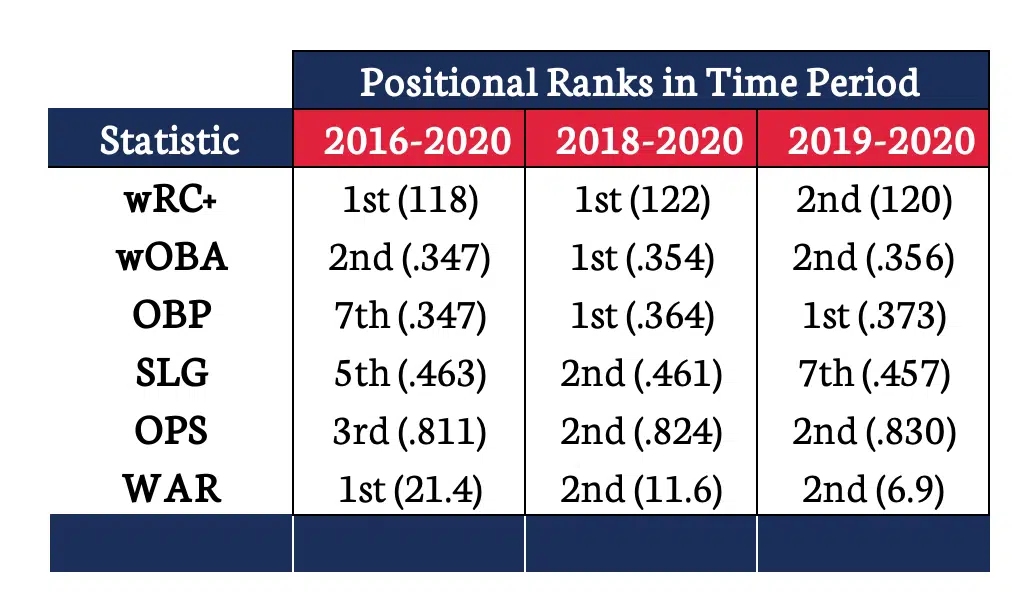
The reason for each breakdown is as follows:
2016-2020: Standard 5-season breakdown among Qualified Hitters
2018-2020: Standard 3-season breakdown among Qualified Hitters
2019-2020: Since James McCann became THIS James McCann (These statistics are among players with at least 550 PAs, rather than just Qualified Hitters)
Grandal’s switch-hitting presence in the middle of the lineup helped stabilize the White Sox’ lineup against RHP this year. Despite McCann’s career resurgence since 2019, he hasn’t been able to surpass Grandal and what he has been able to provide offensively over the past two seasons, except in SLG. In fact, among all of these numbers, J.T. Realmuto has been one of the only catchers to consistently pass Grandal in any of these categories, including both WAR and wRC+. Anywhere Grandal is ranked 2nd, you can bet it’s Realmuto that has something to do with it.
Outside of just consistently high positional ranks, Grandal is incredibly consistent. He was one of just six catchers who had enough plate appearances to qualify for the above statistical categories from 2018-2020. He has been on the field and starting consistently, which has value in itself.
However, there’s that career .241 batting average that bothers a lot of fans. Sure, if you only look at batting average, Yasmani Grandal isn’t one of the better hitting catchers in baseball. However, those who do so would be making the same error they say those who just look at WAR are making: using one data point to prove a point proves absolutely nothing. What Grandal lacks in batting average, however, he more than makes up for through his high BB% numbers and resultant high-OBP approach. This is an incredibly valuable approach for a team that doesn’t walk much.
What value comes from that high on-base percentage, though?
There’s not a perfect answer to this question, but Statcast’s Swing Take Profile gives us some sort of an explanation for it. Created by the fine folks over at Baseball Savant, the Swing Take Profile provides a value for each pitch that a hitter swings at – and doesn’t swing at.
The root of this metric comes from Run Value. When you play baseball enough times, you have enough data to understand the run expectancy in every scenario, as well as how a result in each scenario changes run expectancy. As an example, going from a 0-0 count to a 0-1 count decreases the run expectancy by about 0.05 runs, and would decrease a hitter’s Run Value by 0.05 in their Swing Take Profile. The summation of all these changes in run expectancy for each scenario in the game are combined to create a Run Value for each identified zone of the plate:
1) Heart: Middle of the plate where ~25% of pitches are located
2) Shadow: Outer reaches of the zone where ~40% of pitches are located
3) Chase: Where pitchers try to get hitters to expand their zone; ~25% of pitches
4) Waste: Your classic 0-2 fastball WAY out of the zone; ~10% of pitches
Obviously, hitters do most of their damage in the Heart and Shadow Zones. What did Yasmani Grandal’s Swing Take Profile look like in 2020?

We can aggregate all of this to say that Grandal lost six runs by swinging at 318 pitches and added 13 runs by taking 605 pitches. This becomes a total Run Value of +7 runs in 2020.
Alright, this confirms for us a lot of what we already know. We all wish Yasmani Grandal would swing at more pitches in the zone. Indeed, he certainly does a lot of damage to himself by not swinging at pitches in the zone. In fact, Grandal had the lowest Z-Swing % (50.6%) and Swing % (33.8%) by a pretty wide margin this year. However, his patient approaches makes up a lot of value by remaining patient on pitches hitters would typically chase out of the zone. So, sure, just saying “Yasmani Grandal should swing more” seems like a given. I would happen to agree with you, to an extent. However, understand that the tradeoff would be less value from a patient approach. We wouldn’t know the true benefit, if any, of this trade-off unless Grandal were to adopt this approach.
All of this requires context, however. How do these run value numbers compare to other prominent catchers around the league? Once again, Grandal is among the leaders.
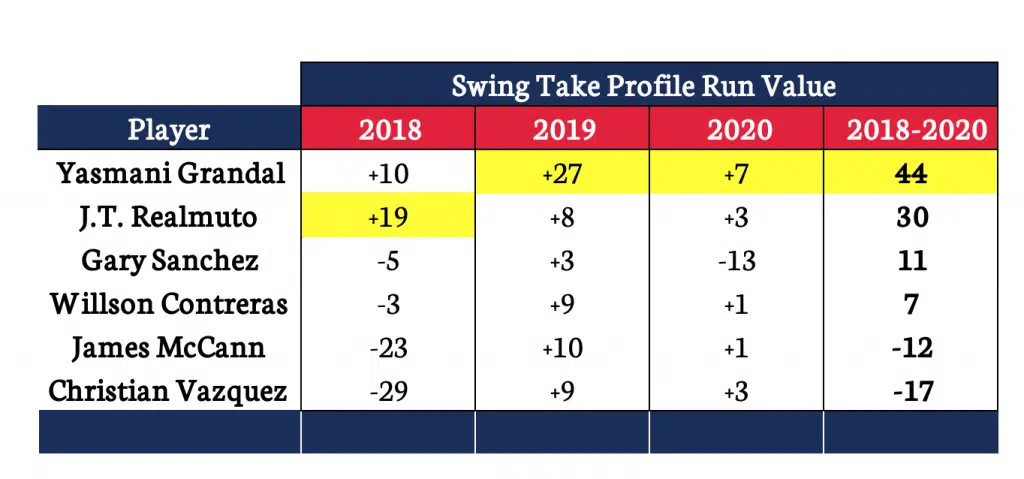
So, that answers the question of whether Grandal’s patient approach at the plate – and his resultant high OBP compared to his average – is actually worth it. Based on the information available in both our large table above and our Run Value table, Grandal’s patience at the plate, while aggravating, still leads to some of the best results offensively among catchers in the league in terms of run creation.
But what about Grandal’s “subpar” 2020? You know, the one where he only slugged .422, thhise lowest mark since 2015? I have a relatively simple answer to this, and it’s one that has a lot to do with sample size. In a season with just 60 games – where Grandal only played 49 of them – each game has the ability to sway statistics more than usual. Don’t believe me? Take a look at this.
1st 5 Games: .118/.238/.118 (.356 OPS), .184 wOBA, 11 wRC+, 14.3 BB%, 42.9 K%
Rest of 2020: .243/.364/.458 (.822 OPS), .357 wOBA, 129 wRC+, 15.6 BB%, 28.3 K%
2016-2019: .241/.347/.467 (.814 OPS), .348 wOBA, 118 wRC+, 13.6 BB%, 24.4 K%
Yes, the season so many have deemed as “subpar” was dragged down by 5 games. Players go through slumps, and we rarely let those slumps determine our evaluation of a player – especially when they have a track record of success. With Grandal, however, these general evaluation rules were forgotten by many.
This entire section can really be summarized in a sentence here: if you’re looking to find an argument that is anti-Grandal in principle, you’re going to have an incredibly difficult time doing so from an offensive standpoint. No matter which way you look at it, Grandal has been a top 2 offensive catcher since at least 2018, and arguably since 2016. Except in the case of J.T. Realmuto, there is absolutely no statistical debate that can be made offensively that can rival Grandal’s offensive output.
Defense
Quantifying the total defensive value of a catcher is difficult because there are so many different aspects to what makes a “good” defensive catcher. Some people focus on pitch framing and put the other areas on the back burner. Others focus on their receiving skills: how many balls get by them? Other people look at how many good plays a catcher can make while avoiding defensive miscues. The good news is that there are sites who take all of these different areas of catching into account and rate catchers accordingly.
We are going to split our look at Yasmani Grandal defensively into two categories: pitch framing and what I call the “ART” of catching (you’ll understand why shortly). There are three really good sources for defensive catching data: Sports Info Solutions (creators of DRS), Baseball Savant, and Baseball Prospectus. Let’s take a look at what each of them has to say about Yasmani Grandal.
Pitch Framing
Sports Info Solutions: Strike Zone (sZ) Runs Saved
Sports Info Solutions’ metric for determining a catcher’s pitch framing abilities is called Strike Zone Runs Saved. sZ is pretty straightforward and is similar in calculation to other pitch framing metrics: “Strike Zone Runs Saved ascertains the contribution the catcher, pitcher, batter and umpire is making in getting more or fewer called strikes than average, converted to a run value.”
Look at the last three season’s worth of games, Grandal has led the league in Strike Zone Runs Saved in both 2018 and 2020. Among the other leaders are some pretty common names.
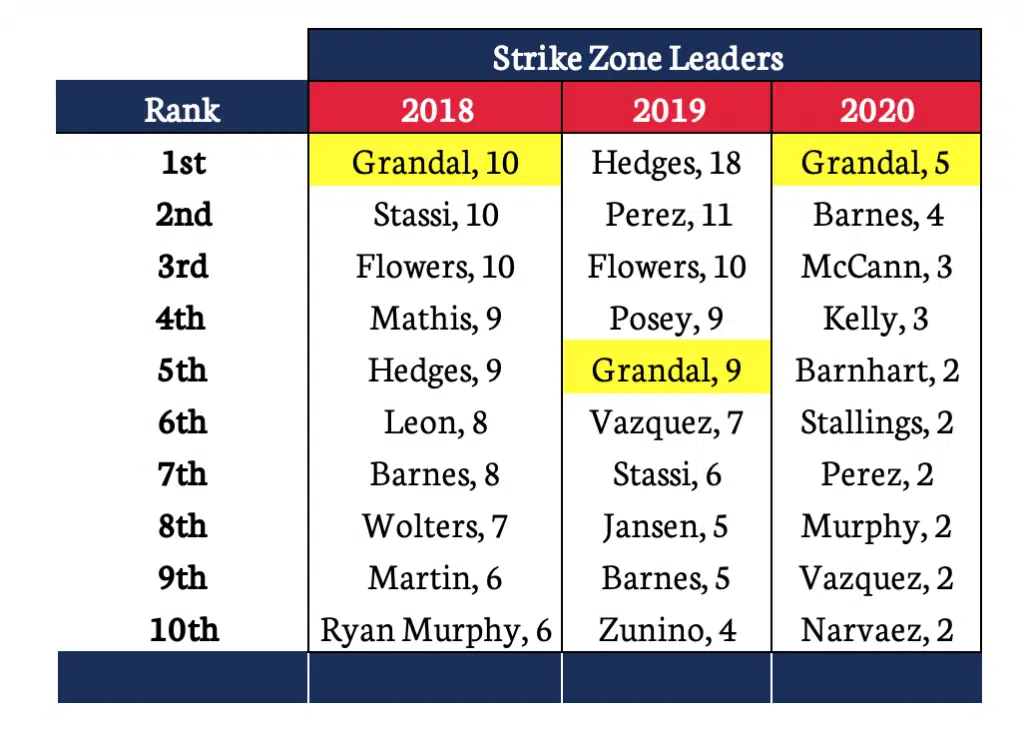
So, from Sports Info Solutions’ perspective, if Grandal isn’t the top pitch framer in the game, he’s at least been top 3 over the course of the last three seasons.
Baseball Prospectus: CSAA and Framing Runs
BP, much like Sports Info Solutions, has a lot of information about different parts of a catcher’s game: stolen base attempts, wild pitches/passed balls, and, of course, framing metrics. They have two different metrics to look at for framing: Called Strikes Above Average (CSAA) and Framing Runs.
CSAA is exactly what it sounds like: how many additional called strikes can be attributed to a catcher compared to the average catcher? This number isn’t as meaningful, however, unless it is put in the context of run value saved over the course of the season, which constitutes Framing Runs. Both are shown below.

Much like with Sports Info Solutions, Baseball Prospectus comes to the conclusion that, on a run prevention level, Yasmani Grandal is at least a top 2-3 catcher in the league since 2018. The only catchers that have accumulated more framing runs than Grandal since 2018 are Austin Hedges (26.0, 2019), Omar Narvaez (4.2, 2020) and Christian Vazquez (4.2, 2020).
Baseball Savant: Runs Extra Strikes
A third way to go about quantifying a catcher’s framing abilities are through Baseball Savant’s Runs Extra Strikes metric. It divides the edges of the zone into 8 different zones and “grades” each catcher based on the amount of strikes they’re able to get in these border zones and convert these additional strikes into run leaderboards. So, for example, Jeff Mathis saved his team 11 runs through his pitch framing in 2018. As you can see, over the past three season, Grandal ranks highly among all catchers.
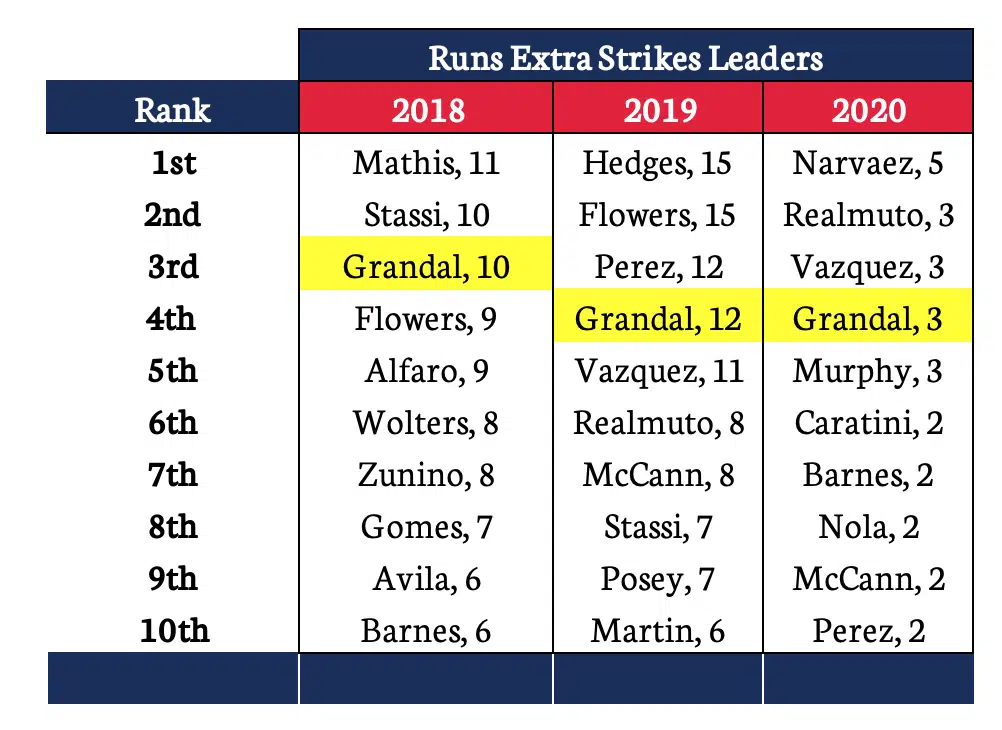
No matter what you think about Yasmani Grandal, and no matter which way you “frame” it (pun absolutely intended), there’s no way to shape the data that doesn’t show that Yasmani Grandal is among the best catchers in baseball in framing. Some sites have him as the best framing catcher in baseball. Others have him around 5th in his worst seasons. There’s little doubt, however, that with framing, Grandal historically saves his pitching staffs runs over the course of a season.
The “ART” of Catching
Obviously, catching goes beyond just framing metrics. Likewise, there is one site that goes beyond the others when it comes to defensive ratings for catchers, and that is Sports Info Solution and their site The Fielding Bible. They have broken down defensive catching into the following areas for grading on a “runs saved” basis.
- ART: Where I got the clever name for this section. This metric measures runs saved based on performance on balls hit in the air, range, and throwing
- Adjusted ER: measures the catcher’s handling of pitchers and accounts for the quality of the pitching staff the catcher works with. This takes Catcher ERA to a deeper level.
- SB: stolen base runs saved. Measures the catcher’s ability to control the running game by taking into account historical stolen base % against pitchers.
- Bunts: measures the catcher’s ability to field bunts.
- Total: total number of runs saved over the course of a season.
- Rank: positional rank for total defensive runs saved.
Here’s Yasmani Grandal’s catching data over the course of his career. The red box is his catching rank: where, defensively – including framing – Grandal ranks over the past five seasons.

As you can see, he had an uncharacteristically bad season in 2019 with the Brewers, driven by historically low performances – by his standards – in ART, Adjusted ER, and SB. I’m not sure what drove this horrible performance, though I have theories I will get into in the next section.
If you sum up the last five seasons’ worth of catching data, here’s the top ten in terms of total defensive runs saved:
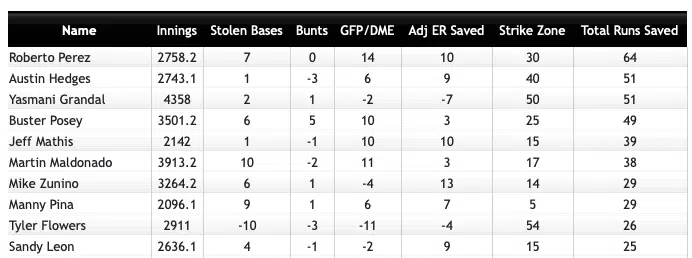
As you can probably see, Grandal’s spot at the top of the defensive rankings is heavily influenced by his pitch framing skills – this is true for many of the catchers at the top of this list. I don’t think any of these above names really surprise you, based on what you’re told from around the game about catchers.
What about each of the other defensive areas? Here’s where Yasmani Grandal ranked in terms of Runs Saved for each of these categories in 2020:

This data confirms a lot of what we already know: Yasmani Grandal is going to make some mistakes behind the plate, and he’s not exactly going to “wow” you with his defense. However, he’s not going to hurt you all that much either – though there are catcher who *could* help you a lot more defensively. However, with those catchers, you give up offense and pitch framing. It’s up to you to determine what’s most important, but in my opinion, I’ll take the offense and pitch framing even if I have to settle for average to below-average defense. As you can see from this list, there aren’t really defensively strong catchers who also frame well.
Robot umpires may or may not be on the horizon. However, until they are, Yasmani Grandal will continue to be a highly rated catcher. The shortcomings and few mental mistakes he has behind the plate are far outweighed by the things he does exceptionally well. Is he an elite catcher in all facets of the game defensively? Hardly. However, it’s clear that, in the long run, Grandal isn’t really going to hurt the team defensively. He may never help them defensively, but that’s a completely different argument.
For argument’s sake, before we move on, I’ll drop McCann’s individual scorecard in here.

In general, this highlights a lot of what we already knew. McCann has improved on his pitch framing, and he’s always been pretty good at throwing out baserunners. This improvement allowed him to be one of the top catchers in the game last season and earned him that 4-year, $40M contract. However, he’s rather average in most other areas, hardly the defensive star a lot of fans will make him out to be. Much like Grandal, his defense isn’t going to hurt you – but, honestly, this can be said on a season-by-season basis for most catchers.
There’s one interesting difference between the two, however, and it’s something we are going to touch on in the next section.
Game-Calling
Ah, game-calling. The third aspect of a catcher’s game that needs to be evaluated when considering a catcher’s overall value.
It’s an area that White Sox fans – myself included – have identified as a strong area for James McCann. As for Yasmani Grandal, fans and evaluators seem to have differing opinions.
Here’s a passage my good friend Beefloaf sent to me when I first asked for people’s opinions on Grandal.

This passage from a Keith Law interview before Grandal signed with the White Sox has stuck with me since Beefloaf sent it. A wider gap between industry and fan evaluation than any other free agent? That’s a big claim. But, let’s take a look at it in the context of what we already know.
We’ve already walked through both offense and defense. While Grandal, at times, is suspect in some aspects of his defensive abilities, he’s clearly a top hitter and framer in the league. Honestly, I find it pretty hard to believe that the difference between three different sites’ framing metrics and the internal baseball world’s framing metrics are different enough to make the difference between the industry view and fan view of Grandal to be “wider than it is on any other free agent.” By all standards above, he’s a top 2-3 catcher in this league. That leaves just one aspect of the game, the one that’s been called out recently by fans: game-calling.
There’s this nagging column in Sports Info Solutions’ breakdown of Yasmani Grandal, one that prevents him from being the top defensive catcher in the league: Adjusted ER Saved. I interpret this number to be Sports Info Solutions’ approximation of game-calling in a statistical form: “Our metric for catcher value in staff handling.”

Though I can’t confirm that this is what Adjusted ER Saved is meant for, the support for my interpretation is in individual test cases. James McCann – heralded as a great game-caller – has accumulated 6 Adjusted ER over the past two seasons with the White Sox. Jeff Mathis – who is in this league because of his pitch-framing and game-calling abilities – had accumulated 8 Adjusted ER over the past three seasons, and 24 over the course of his career. Meanwhile, Yasmani Grandal – the potentially suspect game-caller in question – lost two adjusted ER in 2020, and has lost 7 adjusted ER over the past three seasons.
Let’s start with this: I hate using catcher ERA because it doesn’t take anything into account. A certain catcher could catch the worst pitchers on the team, have a catcher ERA in the upper 5’s and 6’s, and a conclusion could be drawn that “this is a bad game-calling catcher.” The sole ERA number adds no value without further context: which pitchers and opponents go into the creation of that ERA? However, reading between the lines, it appears Adjusted ER Saved understands this and does its best to take this into account, which is why I feel it’s worth studying.
So, the question looms large: is there an appreciable difference in game-calling between Yasmani Grandal, James McCann, and other catchers around the league? Can it be seen in the game-calling itself, helping confirm Adjusted ER Saved’s meaning? Let’s dive in a bit.
In truth, I alone can’t take credit for this section of the article – the newest member of Sox On 35th, Tyler LaVoie (@tlavoie14), first brought this up to me back after I tweeted this out:
He sent me the following:
“Whenever James McCann is catching I can guess nearly every single pitch with the pitch location, but when Grandal is catching, I can’t. So it tells me that McCann and Grandal take different approaches.
McCann calls pitches based on his pitcher. Grandal calls pitches based on the batter.”
It’s a theory worth exploring, because it fits so well in this section. Can Tyler’s thoughts be reflected in the numbers? It’s not an easy ask.
Let’s start with Lucas Giolito though. Is there a difference in game-calling when Grandal starts games versus when McCann does?

There’s some interesting insights just looking at this at a high-level:
- Fastball usage is about the same for both catchers.
- Grandal preferred to call the Changeup or Curveball than the Slider.
- Interestingly, Giolito threw 12 Curveballs this year. Grandal called 11 of them.
The biggest point of interest for me is the difference in offspeed usage. Though it doesn’t feel like much, a 3-6 percentage point difference shows the start of some tendencies developing.
To take this a step further, we took a look at some individual batters that Giolito faced this season with both McCann and Grandal as his catcher. The sample size is limited, though interesting, in a few cases below.
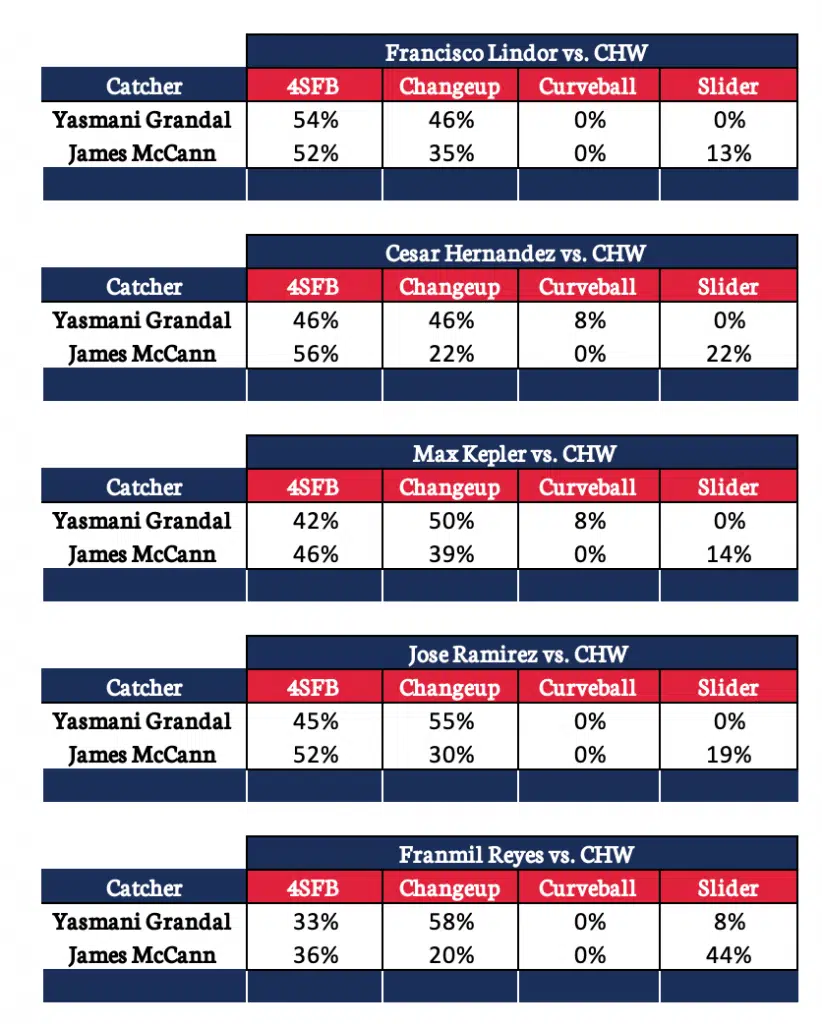
These discrepancies between especially changeup and slider usage are astounding in some cases. Grandal clearly prefers a fastball/changeup combo with Giolito, while McCann will more often mix Giolito’s third pitch in – his slider.
Though Giolito has been the test case this far, this information is not unique to Giolito. Take a look at the rest of the White Sox’ starting staff from last year.
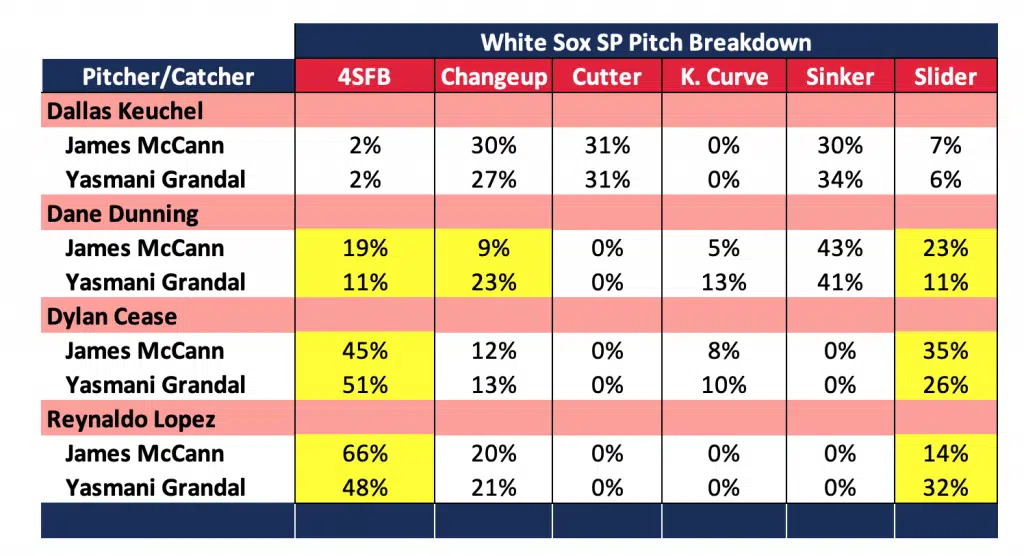
What do we learn from these? Here’s a few things:
- Dallas Keuchel is the seasoned vet of this group. He likely has a large say in what pitches are called, and that’s why you won’t see much of a discrepancy here. I wouldn’t be surprised if Keuchel shook off pitches he didn’t like.
- As for the younger pitchers, the discrepancy is a lot different. For Dunning and Cease, we see a situation similar to Giolito: Grandal favors a fastball/changeup combination, while McCann prefers to mix in the slider much more. With Dunning, we also see Grandal try and mix in his Curveball more – similar to Giolito.
- For Lopez, I think that’s the clearest case of understanding your pitching staff. McCann is more familiar with Lopez and understands his slider isn’t a fantastic pitch after seeing him struggle in 2019. So, when possible, he will stay away from it. However, Grandal will stick to the plan, calling a slider whenever the count/batter deems it necessary.
I think the following is a pretty good summary: Grandal will work to establish all of his pitchers’ pitches in a start, even when they aren’t always comfortable with them. He understands and trust his scouting reports. On the other hand, McCann will play each game differently and let how each pitcher “feels” in the bullpen or what pitches they were throwing well during warmups dictate the gameplay as much as he can. Both pitchers utilize a scouting report, but one is more willing to deviate from it than the other. Grandal is a conventional catcher. McCann personalizes his catching to the pitcher on the mound far more than Grandal does.
Because of the above, these two tweets make a lot more sense now.
Realistically, in baseball, you’re taught from a younger age not to double up on pitches, much less triple up on pitches. Rarely would you find data, except in extreme circumstances, where a hitter faces too many of the same offspeed pitches in a row. Grandal knows this, knows the numbers, and reacts accordingly. McCann, on the other hand, played a different version of Game Theory, betting on the fact that no one would expect him to call nine changeups in a row. It’s a comfort pitch for Giolito clearly – and one McCann has consistently called in important counts. Truthfully, what I’ve shown above for pitch-calling is only the beginning of this – and is something that Tyler and I will certainly write about in the future. This goes all the way back to Grandal’s 2019 Brewers days as well.
What does all this even mean in the grand scheme of things? Well, it means a couple of things. Let’s start with the game-calling differences themselves. We can once again use Giolito as a test case. Here’s what each catcher calls in different places in the count – ahead in the count, behind, etc.
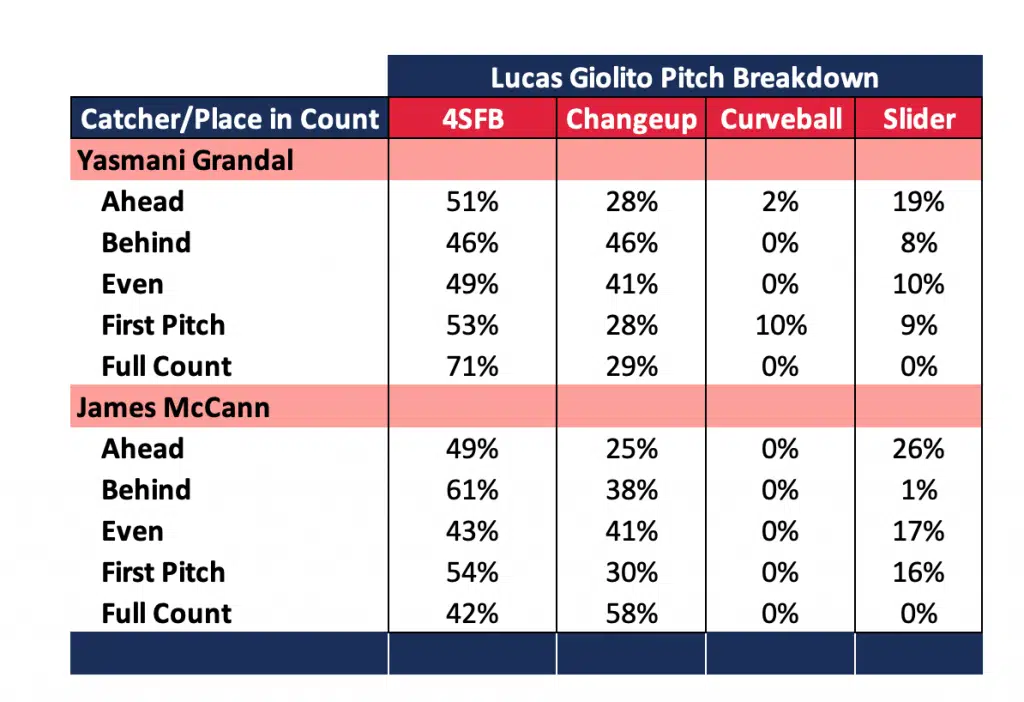
These are pretty big differences just based on the catcher in the same count. Grandal uses the changeup and slider to set up the fastball, while he also goes to the fastball for the comfort pitch. McCann, on the other hand, uses the fastball to set up the changeup and slider and uses the changeup and slider as comfort pitches. This is evidenced based on what the counts each catcher calls certain pitches – look at the differences in full counts, for example. In addition, it also means that McCann is much more likely to deviate from a scouting report on a hitter and base an at-bat based on what is working at that moment.
Now, granted, there are some assumptions taken here. Grandal caught Giolito early on in the season, and perhaps Giolito hadn’t fully established all of his pitches for the season yet. However, based on the numbers and the tweets we looked at above, I do believe that this at least suggests game-calling is where the difference in evaluation comes from for Yasmani Grandal between the industry and fans. Fans – for the most part – don’t see this information as often as the industry does. But it’s also a part of why James McCann earned a 4-year, $40M deal this offseason. The industry talks with pitchers in the game, they understand which catchers pitchers like to throw to, and they understand the game plan catchers have for tackling a game or scouting report. McCann earned this deal because pitchers love pitching to him. He has a good “feel” for his pitching staffs.
Does this make James McCann a better game-caller than Yasmani Grandal? Potentially. The industry and the numbers (Adj. ER) would seem to say he is – at least over the past two years while McCann was in Chicago. Part of the benefit for McCann in Chicago has been an improved staff and familiarity with the group. Grandal, on the other hand, switched teams twice from 2018-2020. How these numbers improve/worsen in 2021 will be of particular interest to me. I do think the switch for the first time in his career as a starter was part of the reason for his rough year in Milwaukee.
However, would the above facts make him a better catcher than Yasmani Grandal? Well, that’s what our conclusion is for below.
The Verdict
If you’ve made it this far, I have to thank you for reading all of this. I hope it was informative for you. Now, let’s bring it home. Here are the main takeaways:
- Grandal, offensively, is a top 2 catcher in baseball. This really can’t be disputed.
- Grandal, as a pitch framer, is one of the top 3 catchers in baseball.
- Grandal, defensively, is average at best. He won’t save you games, but he really won’t lose you them either.
- According to statistics and a look into pitcher breakdowns, Grandal’s game-calling leaves something to be desired; namely, a little unconventionality. These statistics and pitcher breakdowns should be monitored next season, however.
Before all of this, I already was firmly in Yasmani Grandal’s camp. His $18M/year contract was deserved in my eyes, and a worthy price to pay for who I considered a top 2 catcher in baseball. After walking through all of this, you’re going to have a hard time convincing me that Yasmani Grandal wasn’t worth the contract or that he isn’t among the best catchers in the game.
There is no appreciable difference in any facet of the game between Yasmani Grandal and J.T. Realmuto, the two consensus top catchers in baseball. They are on par with each other offensively, Grandal is the stronger pitch framer, and the two are both defensively below-average (Realmuto’s strongest asset is his ability to stop the run game). Additionally, there is a large enough gap between these two backstops and the rest of the league to put them in a league of their own.
Most catchers today aren’t able to provide on both sides of the ball, though James McCann has the ability to play himself into this tier. He has to prove that, over the course of 150 games, that the bat is indeed legitimate. If it is, his game-calling and stolen base abilities – with his apparently improve framing – will play him into the top tier of catchers. He’s put some good partial seasons together, but it’s time for him to put everything together over the course of 1-2 full seasons. Until he does, based on the data above, it’s pretty impossible to make an argument for McCann > Grandal as an overall catcher.
How do I explain Grandal’s miscues behind the plate? Human error and selection bias. These guys are going to make mistakes, but the positives have to outweigh the negatives. For Grandal, they do. However, when someone is trying really hard to prove their point, the few miscues a player makes become magnified, and the loudest voices in the room often always win. It’s just like shifting in baseball: it works, and there’s numbers to prove it. However, it’s the times where the ball sneaks through the shortstop hole that detractors will decry the “takeover” of analytics in baseball. It’s a game of percentages, not guarantees.
Truthfully, I’m not sure what to make of Grandal’s game-calling. The numbers (Adjusted ER Saved) show that he’s not the game’s best pitch caller as of right now, potentially due in part to his lack of “feel” for his most recent staffs. However, he did post a positive number of Adj. ER Saved in 2018 in his third season with the Dodgers. Perhaps with time and familiarity with a staff, the communication with and understanding of the pitching staff improves? This is one area we will have to wait and see – and, as I’ve said before, what’s been uncovered by Tyler and I is only the tip of the iceberg.
At the end of the day, Yasmani Grandal, just like any player, has some identifiable shortcomings as a player. However, Grandal’s strengths are so strong that they more than make up for his identified weaknesses. This is what you are looking for in a player. Some of those things he is doing that drives many fans nuts is actually helping him perform as one of the most productive catchers in the game.
I don’t know if this has changed any opinions on Grandal. I’ve presented the facts available to us – it’s up to you to determine how much you buy into the argument that I’m trying to make. But, in my eyes, the argument is pretty clear. If given the opportunity to choose between James McCann and Yasmani Grandal, I’ll take Grandal every time. His contract is more than worth what the White Sox will get in production over the next three years. His hitting profile looks as if it will age well, and his pitch framing will continue to be valuable as long as robot umps aren’t around. As for the pitch-calling, I’m playing wait and see – but I can understand why the industry has concerns (and why McCann earned his contract). Your concerns about game-calling shouldn’t prevent you from seeing all the great things Grandal does.
In short, if you’re looking for one of the best catchers in baseball, you don’t have to look much farther than the South Side of Chicago.
Thoughts? Comments? Let me know below or on Twitter! @jlazowski
Featured Photo: MLB Trade Rumors (@mlbtraderumors) / Twitter

A lot to digest here as a die-hard baseball fan. It also reminds me of why I loved astronomy as a kid but never pursued it beyond high school because I couldn’t get past all the math and physics. lol
Still in all, I somehow made it through all of these numbers, all the way to your and summary and conclusion. I appreciate the effort you put into it. As a baseball fanatic and a self confessed borderline OCD personality, I could never have produced anything of this magnitude. Keep up the good work…I think?
This article definitely ended up being much longer than I thought it would be, haha. I did my best to explain my rationale all the way through, and I appreciate you giving it a read! I really appreciate the kind words.
To me, Grandal’s value comes in his ability to generate walks and frame pitches. Obviously he’s a great hitter and a great framer, but his power is average and his BA is iffy. His arm is borderline acceptable (in my opinion). baseball-reference.com WAR hates him.
I love him as a player, but I need to see a good performance in 2021 to make me believe that he’s worthy of the big contract that the White Sox gave him.
Just my two cents.
Big mistake to let mc cann sign elsewhere now we are stuck with Zack collins who can’t catch or hit hahn you blew ja@aol.xim
With the plethora of TJ surgeries, I can’t help but wonder if pitch calling has an impact. Any thoughts on a correlation between certain pitch frequencies and the likelihood of injury? Also, are we using pitch calling to make up for poor execution, placement?
Is it possible Yaz doesn’t call the slider because he knows he has trouble tracking and catching the ball? Eye test to me shows Yaz fighting the ball instead of receiving it. Could his defensive deficiencies lead to affecting how he calls a game? I don’t doubt his numbers are lying, but there has to be a reason 2 winning organizations at the time decided they didn’t need him. I feel McCann fit these Whitesox better than Yaz. We have a group of young aggressive players who sort of go against the grain of a lot of baseball sensibilities. You saw frustration from your ace when he was paired with Yaz. McCann handled the staff better last year. The games James caught just seemed easy. He also put up greater or equal stats in less opportunities and out produced him the previous year as well. I think 2 things can be true, Yaz is a better statistical player over their careers, but McCann is just better for this Whitesox team.
I’m glad you touched on the subject of the robo-ump in your Yasmani Grandal dissertation. I personally believe that MLB is dropping the ball (pun intended) by prioritizing cockamamie rule changes like the extra-inning farce and the potential regulation of shifts. The automated strike zone should have the highest priority going forward, especially since the umpires have already signed off on it. It would eliminate the pitch-framing stat which would negatively impact a catcher like Grandal, perhaps even James McCann since he has also shown recent improvement with that metric. It’s also fascinating to contemplate the effect the new strike zone will have on hitters like Grandal who already excel with their plate patience and OBP ability, to say nothing of the pitchers like Greg Maddux who’s success relied on their ability to live on the periphery of the zone.
I hope that the automated zone is a serious part of the new CBA discussions and will be implemented in time for the 2022 season provided we have one considering all the labor issues facing the owners and players. What baseball doesn’t need is a lost or shortened season in the wake of a pandemic that could very well result in more lost games this year.
Another factor that wasn’t really brought up in the Grandal versus McCann debate was how each player might perform over the course of their latest free agent contracts. Who figures to produce better numbers over their 4 year contracts, Grandal through 2023 or McCann through 2024. Age could play a factor to say nothing of the wear and tear that each catcher has accrued thus far in their careers. Sounds like the subject of yet another long article (yikes!). lol